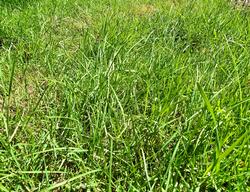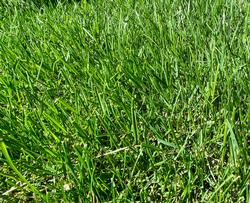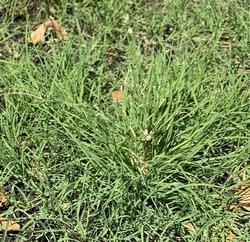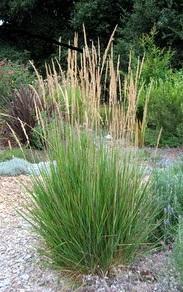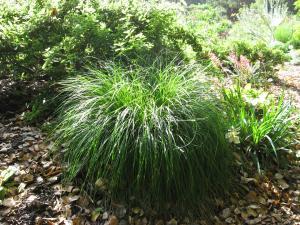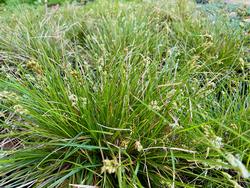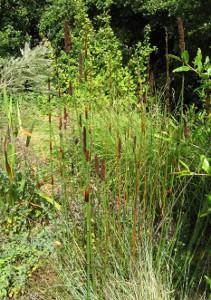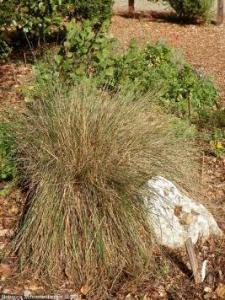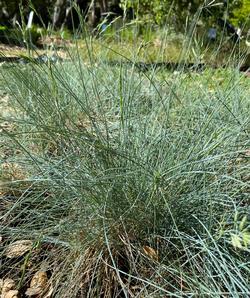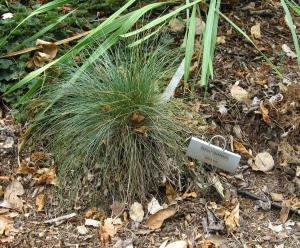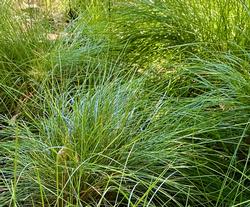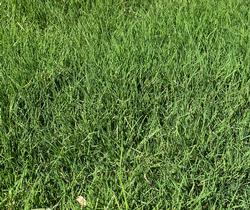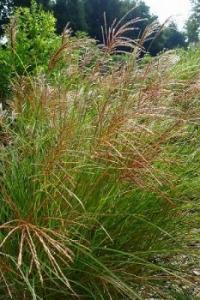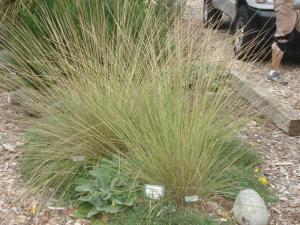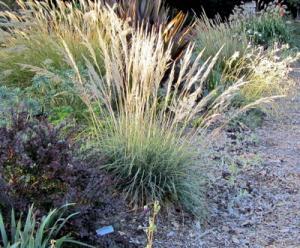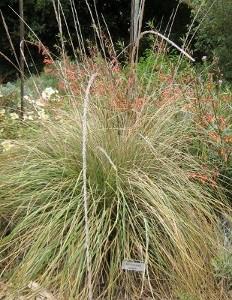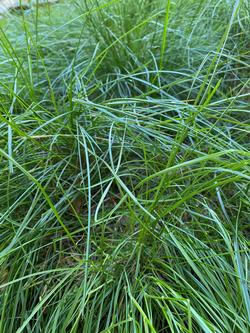Water Wise Plants
Here's a full list of all our water wise plants. You can also view an image gallery, or view the plants by categories.
Agrostis pallens
Pronunciation
ag-ROS-tis PAL-ens
Common Name
Native Bentgrass
Plant Type
Grass
Mature Size
2–6 in. mowed; 1–2 ft. unmowed
Water Requirements
Moderate: water weekly until the root ball is wet
Sun/Shade Requirements
Full to half sun, shade
Wildlife
Flower Color
Green to buff spikelets
Where to See
Maintenance- Design- Planting Tips
Design use: Conventional lawn substitute for playing on when mowed, or meadow if left unmowed. Takes light foot traffic. As a meadow grass, it's good in bioswales, rain gardens, and under trees and shrubs.
Native Bentgrass is a low impact, thin-bladed evergreen grass. It is a cool season grass and can brown up without enough summer water. A California native grass, it is drought tolerant and spreads by both under- and above-ground rhizomes and stolons. If used as a lawn, it needs consistent mowing to 2–3 in., or it can be left unmowed for a meadow-like look. Deer resistant. Fertilize in February–March and in August–September. |
Bolero Plus™
Pronunciation
Bo-LEHR-oh Plus
Common Name
Bolero Plus™
Plant Type
Grass
Mature Size
Mow to 2–3 in.
Water Requirements
Moderate: water weekly until the root ball is wet
Sun/Shade Requirements
Full to half sun
Wildlife
Flower Color
Where to See
Maintenance- Design- Planting Tips
Design use: Conventional lawn substitute, ideal for playing on.
Bolero Plus™ is a proprietary (Delta Bluegrass Co.) blend that is 90% dwarf fescue and 10% bluegrass. It is a cool season grass with a fine bluegrass-like texture that stays dark-green year-round. Bolero Plus™ can take high impact foot traffic. It is drought tolerant and low maintenance as it is slower growing with fewer clippings. Fertilize in February–March and in July–August. |
Buchloe dactyloides (UC Verde)
Pronunciation
BOOK-chlo-ee DAK-tah-loydes
Common Name
California Buffalograss
Plant Type
Grass
Mature Size
4–6 in. high, spreading
Water Requirements
Moderate: water weekly until the root ball is wet
Sun/Shade Requirements
Full to half sun
Wildlife
Flower Color
Where to See
Maintenance- Design- Planting Tips
Design use: Conventional lawn substitute for pets and kids to play on if mowed; meadow if left unmowed.
California Buffalograss is a durable grass with soft green leaves. It is a warm season grass, winter dormant, has a deep root system, and spreads by above-ground stolons. A U.S. native grass, it is low maintenance, drought tolerant, and almost pollen-free. Use a slow-release fertilizer in June and August. Mow to 2–3 in. height in summer or mow once a year for a meadow landscape. |
Calamagrostis acutifolia ‘Stricta’
Pronunciation
kal-ah-mah-GROSS-tiss ah-kew-tih-FLOOR-ah
Common Name
Feather Reed Grass
Plant Type
Grass
Mature Size
2-3 ft. tall and wide, flowers to 6 ft.
Water Requirements
Low: water every three weeks until the root ball is wet
Sun/Shade Requirements
Full to half sun
Wildlife
Flower Color
Taupe
Where to See
Maintenance- Design- Planting Tips
Calamagrostis is a low maintenance plant with big impact in the garden as a vertical accent. They can also be massed to make a low growing screen. In late winter, cut back to several inches above the ground to renew the plants. Alternatively, simply rake out the old growth in the spring
PADG notes: We have used two plants to mark an entryway to the garden. |
Carex divulsa
Pronunciation
KARE-eks dee-VOOL-sah
Common Name
Foothill Sedge
Plant Type
Grass
Mature Size
2 ft. tall and 1 ft. wide
Water Requirements
Very Low: water deeply several times a summer
Sun/Shade Requirements
Full to half sun, shade
Wildlife
Flower Color
No flowers
Where to See
Maintenance- Design- Planting Tips
Foothill sedge makes a lovely informal ground cover in shady areas. With occasional watering, this plant stays green over the entire summer. It will survive full sun but can begin to look ratty in the summer.
This plant was once considered a California native, but that has recently been disproven. The new name is Carex divulsa, but it may still be sold in nurseries as Carex tumulicola. PADG notes: At the end of winter, many people cut this plant back to several inches above the ground, but that has not been necessary at the demonstration garden. Because plants are in the shade, they don’t become tattered. Reseeding has also not been a problem, probably because of extensive bark mulch and drip irrigation in the water wise garden. |
Carex praegracilis ‘Chisai’
Pronunciation
CARE-ex Pree-GRA-si-lis (GRA as in grass)
Common Name
Meadow or Field Sedge 'Chisai'
Plant Type
Grass
Mature Size
6–8 in. high, can be mowed to 3 in.
Water Requirements
Low: water every three weeks until the root ball is wet
Sun/Shade Requirements
Full to half sun
Wildlife
Flower Color
Buff, on short flower spikes
Where to See
Maintenance- Design- Planting Tips
Design use: Meadow, or mowed for look and feel of a traditional lawn, takes light foot traffic. Good under oaks, around stones, or mixed with other grasses.
Meadow Sedge ‘Chisai’ is a short, dark-evergreen clumping grass with narrow leaves. Flowers appear in spring and summer on 6–10 in. spikes. Chisai is drought tolerant yet needs summer water to keep from going dormant. It spreads slowly by rhizomes. California native, deer resistant, no fertilizer although compost can be used. Cool season plant. |
Chondropetalum tectorum
Pronunciation
kon-dro-PET-al-lum tek-TOR-um
Common Name
Cape Rush
Plant Type
Grass
Mature Size
4-6 ft. tall and wide
Water Requirements
Low: water every three weeks until the root ball is wet
Sun/Shade Requirements
Full to half sun
Wildlife
Flower Color
Tan brown bracts
Where to See
Maintenance- Design- Planting Tips
Chondropetalum is a low water plant from South Africa that has a nice reed-like look. Many garden designers favor it as a specimen for its strong architectural lines. It is often use in modern designs and in pots as the “thriller.” Overwatering the plant will make it floppy. Remove old stems to highlight new growth. It can also be sheared to ground just as new sprouts start to show.
PADG notes: We also tried Juncus, a similar looking plant, but found it did not do well with once every three weeks watering. |
Festuca californica
Pronunciation
fess-TEW-kuh kal-ih-FOR- nih-kuh
Common Name
California Fescue
Plant Type
Grass
Mature Size
2 ft. high and wide, with inflorescence 2 - 3 ft. high
Water Requirements
Very Low: water deeply several times a summer
Sun/Shade Requirements
Full to half sun, shade
Wildlife
Flower Color
Golden
Where to See
Maintenance- Design- Planting Tips
Festuca californica is a commonly planted California native grass. It is larger than many of the Festucas, reaching two feet or more in height and has a softer more arching habit. Unlike many California natives, this plant can take moderate water and will stay green and lush with regular watering. Without regular summer watering, it will go dormant. Festuca californica is tough and resilient. To prevent reseeding, be sure to deadhead in early summer.
|
Festuca glauca
Pronunciation
fes-TOO-ka GLAW-ka
Common Name
Blue Fescue
Plant Type
Grass
Mature Size
1 ft high and 10 in. wide
Water Requirements
Moderate: water weekly until the root ball is wet
Sun/Shade Requirements
Full to half sun
Wildlife
Flower Color
Pale green turning to buff
Where to See
Maintenance- Design- Planting Tips
Design use: Meadow
Blue fescue is a drought tolerant, evergreen bunchgrass with narrow blue-green leaves that form a mound. Flowers appear in summer on thin 1 ft. high spikes with seeds that easily self-sow. This grass needs occasional water and good drainage. It tends to brown out in the middle and can be raked out in winter or divided and replanted. In a low water garden, these grasses seem to hold their blue green color better in the shade. Native to southern France, deer resistant, no fertilizer needed although compost can be used. Cool season plant. |
Festuca idahoensis
Pronunciation
fess-TOO-kah eye-duh-ho-EN-sis
Common Name
Idaho Fescue
Plant Type
Grass
Mature Size
1 ft. to 2 ft. tall and wide
Water Requirements
Low: water every three weeks until the root ball is wet
Sun/Shade Requirements
Shade
Wildlife
Flower Color
No flowers
Where to See
Maintenance- Design- Planting Tips
Idaho fescue is common native grass in California and many other western states. Without summer water, they turn brown and scraggly. Even with occasional summer water, Festucas do better shadier areas than in full sun. Miscanthus, another type of grass, does better in full sun, but is larger than Festucas.
PADG notes: The Palo Alto Demonstration Garden is still searching for a grass that is low growing and does well in full sun with limited water. |
Festuca rubra ‘Molate’
Pronunciation
fes-TOO-kah ROO-bra moh-lah-teh
Common Name
Creeping Red Fescue
Plant Type
Grass
Mature Size
12–18 in. high, can be mowed to 1.5–2.5 in., 2–3 ft. wide
Water Requirements
Low: water every three weeks until the root ball is wet
Sun/Shade Requirements
Half sun to shade
Wildlife
Flower Color
Light-colored seedheads on 2–3 ft. stalks
Where to See
Maintenance- Design- Planting Tips
Design use: Meadow, or mowed lawn alternative, takes light foot traffic. Deep roots for slope stabilization. Good in masses or mixed with mounding shrubs.
Creeping Red Fescue ‘Molate’ is a clumping grass with lush, long flowing evergreen leaves. Flowers appear in spring and summer, spreads by underground rhizome. This California native fescue is drought tolerant when established and looks best with water in the summer. Plant in winter, can be cut back in summer. Fairly deer resistant. Low maintenance, no fertilizer, can use compost. Cool season grass. |
Latitude 36™
Pronunciation
–
Common Name
Latitude 36™
Plant Type
Grass
Mature Size
Mow to 2 in.
Water Requirements
Moderate: water weekly until the root ball is wet
Sun/Shade Requirements
Full to half sun
Wildlife
Flower Color
No seedhead production
Where to See
Maintenance- Design- Planting Tips
Design use: Conventional lawn substitute, ideal for playing on.
Latitude 36™ is a proprietary (Delta Bluegrass Co.) hybrid Bermuda grass with a soft feel and fine texture. It is a warm season grass that is winter dormant with an early spring green up. Latitude 36™ can take high impact foot traffic. It has outstanding drought tolerance, quick divot recovery, and little to no seedheads so does not spread. Use a slow-release fertilizer in June and August. Mow to 2 in. |
Miscanthus sinensis 'Yaku Jima'
Pronunciation
mis-KAN-thus sih-NEN-sis
Common Name
Silver Grass 'Yaku Jima'
Plant Type
Grass
Mature Size
2 ft. to 3 ft. wide and tall with plumes rising 4 ft. to 5 ft.
Water Requirements
Low: water every three weeks until the root ball is wet
Sun/Shade Requirements
Full to half sun
Wildlife
Flower Color
Striking golden plumes in fall
Where to See
Maintenance- Design- Planting Tips
There are many cultivars of Miscanthus on the market that vary in size and foliage color including silver and reddish brown. The cultivar 'Yaku Jima' is a U.C Davis “All Star” plant.
From a design perspective, the delicate foliage and showy plumes of Miscanthus add movement and texture to the garden. The plumes look especially lovely in the fall afternoon light. To keep a fresh look, cut Miscanthus to the ground in winter and divide every few years. That is the only maintenance needed for these trouble-free plants. Miscanthus sometimes takes a year or so to get established. PADG Notes: Miscanthus 'Yaku Jima' is a favorite of Roberta Barnes, one of the founders of the Palo Alto Water Wise Demonstration Garden. She has found Miscanthus to be one of the best-looking grasses for full sun and low water. There have not been any problems with this grass reseeding in the Demonstration Garden. |
Muhlenbergia dubia
Pronunciation
muh-len-BER-jee-ah DOO-bee-uh
Common Name
Pine Muhly
Plant Type
Grass
Mature Size
2 ft. to 3 ft. wide and tall with plumes rising 4 ft. to 5 ft.
Water Requirements
Low: water every three weeks until the root ball is wet
Sun/Shade Requirements
Full sun
Wildlife
Flower Color
No flowers
Where to See
Maintenance- Design- Planting Tips
Muhlenbergia dubia from the southwest U.S. is a favorite grass for the summer dry garden. It looks very similar to the more common Muhlenbergia rigens (deer grass), but it is a third of its size. That makes this plant a better choice for pots and small spaces.
Like most grasses Muhlenbergia dubia really shines in the fall when its graceful leaves add movement and texture to the garden. PADG notes: Every spring, older growth is raked out to encourage new green leaves. Every three years, the plant is sheared down the ground. No other maintenance is done for this plant. |
Muhlenbergia emersleyi
Pronunciation
muh-len-BER-jee-ah e-MERS-lee-eye
Common Name
Bull Grass
Plant Type
Grass
Mature Size
1 1/2 ft tall and 3 - 4 ft wide
Water Requirements
Low: water every three weeks until the root ball is wet
Sun/Shade Requirements
Full to half sun
Wildlife
Flower Color
No flowers
Where to See
Maintenance- Design- Planting Tips
Muhlenbergia emersleyi is a wonderful grass to include in perennial flower beds because it doesn't get too big. In the late summer and fall this grass has attractive reddish flower spikes on green foliage. The winter form is lovely as well. Some describe the winter color as cream, tan or brown. This grass would look attractive planted in a larger group or even in a meadow.
This plant can be hard to find, but is well worth requesting from a nursery as a special order. PADG Notes: This grass is extremely low maintenance and unlike many other grasses doesn't need to be divided every couple years. To keep this grass attractive, the old foliage is raked out to make room for the green spring growth. |
Muhlenbergia rigens
Pronunciation
muh-len-BER-jee-ah RIG-ens
Common Name
Deer Grass
Plant Type
Grass
Mature Size
3 ft. wide and tall
Water Requirements
Low: water every three weeks until the root ball is wet
Sun/Shade Requirements
Full to half sun
Wildlife
Flower Color
No flowers
Where to See
Maintenance- Design- Planting Tips
Grasses are the backbone of late summer and fall dry perennial gardens, adding movement and texture. The graceful leaves of grasses look particularly beautiful when highlighted by the late afternoon sun.
Muhlenbergia rigens is a reliably pretty California native grass. The flower stalks are persistent and look attractive year-round. The UC Davis Arboretum, which has selected Muhlenbergia as one of their "All Stars", suggests using it as a low informal screen. Muhlenbergia requires very little maintenance. UC Davis recommends shearing Muhlenbergia a couple inches above the ground in the early spring every three years to encourage new green growth. California Native Plants for the Garden suggests periodically raking out dead foliage with a fan rake. Otherwise, this is a maintenance-free plant. PADG notes: This plant is used as an accent plant in both the native and non-native garden beds with good results. PADG Garden also grows Muhlenbergia dubia, a smaller cultivar. This is an attractive low-water plant, although the UC Davis Arboretum suggests giving M. dubia slightly more water than M. rigens. |
Native Mow Free™
Pronunciation
–
Common Name
Native Mow Free™ Grass Blend
Plant Type
Grass
Mature Size
1 ft. to 2 ft. tall and wide
Water Requirements
Low: water every three weeks until the root ball is wet
Sun/Shade Requirements
Half sun
Wildlife
Flower Color
Green-buff, on 2 ft. stalks
Where to See
Maintenance- Design- Planting Tips
Design use: Meadow, good for soil stabilization on slopes. Can mow to 4–6" for around stones and pathways, takes light foot traffic. Can be used as a lawn substitute.
Native Mow Free™ is a proprietary (Delta Bluegrass Co.) festuca blend of California natives that is lumpy and mounding with long and narrow evergreen leaves. The blend includes idahoensis, Molate festuca rubra, and Western Mokelume festuca occidentalis. This slow-growing, versatile grass can be mowed to 6 in. monthly or 12 in. yearly. Fairly deer resistant. It is low maintenance, no fertilizer, can use compost. Cool season grass. |







